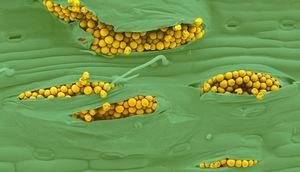ISSUED BY THE JOHN INNES CENTRE
The scientists who recently identified dramatic changes in yellow rust populations affecting wheat in the UK, have just been awarded £1.2 million to develop a new, quicker, cheaper version of their field–based diagnostic tool. This project will improve the UK’s national surveillance programme by examining hundreds more yellow rust samples annually.
Yellow rust is a fungal disease with the potential to destroy entire wheat crops; those plants which do survive often have lower quality grain.
The team of five scientists from the John Innes Centre (JIC), The Genome Analysis Centre (TGAC) and the National Institute of Agricultural Botany (NIAB) believe the larger data sample resulting from this exponential increase in the accuracy and frequency of tests will mean they get a much clearer, more detailed picture of the different strains of yellow rust in the UK, and eventually, across the world. It will also substantially increase the speed of results being reported to UK farmers and breeders, from many months to a period of just a few weeks using this new exciting approach.
Working with fellow scientists in 13 international partnerships across six continents and the UK Cereal Pathogen Virulence Survey (UKCPVS), the team plan to collect samples from across the world and capture in a comprehensive manner the global diversity of the yellow rust pathogen. They believe this will enable them to develop the most accurate, fast and effective field-based diagnostic test yet.
In addition to helping breeders and farmers make key decisions about which resistant varieties of wheat to breed and grow and when to treat their crops, the scientists also hope this data will give them a better understanding of how the pathogen travels across oceans and continents. Having the ability to identify how the pathogen moves from one country or continent to another, for example via movements of people or plants, could help the UK and other countries develop specific precautions to prevent or slow its spread.
The scientists collaborating on this strategically important project are Dr Diane Saunders from TGAC and JIC, Dr Cristobal Uauy of JIC and NIAB, Dr Robert Davey from TGAC and Drs Jane Thomas and Sarah Holgate from NIAB and UKCPVS.
Dr Diane Saunders said: “We are hot on the heels of the yellow rust pathogen. We will work with scientists across the world to track it down and monitor its movement. By developing a new cheaper, rapid diagnostic test we will give UK breeders and farmers regular, reliable data on the strains which are present in the UK wheat population and empower them to take early action to choose resistant varieties or protect their crops. ”
The development of the quicker, cheaper version of the test and the new online tracker have been funded through a combination of industry and public funding with 10% coming from 7 industrial partners including AHDB Cereals & Oilseeds, Syngenta, BASF, KWS, RAGT, Agrii and Limagrain; and 90% funding from the Biotechnology and Biological Sciences Research Council (BBSRC). Both the John Innes Centre and The Genome Analysis Centre receive strategic funding from the BBSRC.
Work on this project is due to begin in July 2015. At the completion of the project, the new field-based test which uses Illumina sequencing technology will be directly integrated into the UKCPVS programme.
